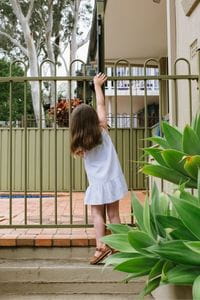
Royal Life Saving WA's Rachel Murray with Martin Roddis from Building and Energy
Celebrating 20 years of saving little lives in WA
20 years after legislation was enacted requiring isolation fencing for new residential swimming pools, Royal Life Saving WA is celebrating the impact of the changes on saving young lives in Western Australia. Since November 5 2001, it has been compulsory for all new home swimming pools in WA to have a barrier isolating the pool from the house. Further requirements were also implemented for homeowners with older pools to upgrade their safety barriers, restricting access from the house, with a five-year phase-in period. The laws aimed to protect young children, following decades of unacceptably high swimming pool drownings involving toddlers.
Rachel Murray, Royal Life Saving WA Keep Watch Coordinator, says the combined effect of the legislation, regular pool fencing inspections and community education on toddler drowning deaths has been extraordinary. “The loss of a child to drowning is devastating and our current pool barrier legislation has saved many families from this heartbreak. In the 15 years prior to the introduction of this legislation, on average nine children under the age of five fatally drowned each year. In the 20 years since, on average fewer than four toddlers have fatally drowned each year, with approximately half of these (51%) occurring in home swimming pools.”
 While these figures represent great progress, too many WA children are still drowning in home pools, often gaining access to the pool area due to a fault in the barrier. This includes the gate, door or barrier being faulty or not self-closing/self-latching (56%), the gate being propped open (15%) or children using an object to climb over the fence (5%).
While these figures represent great progress, too many WA children are still drowning in home pools, often gaining access to the pool area due to a fault in the barrier. This includes the gate, door or barrier being faulty or not self-closing/self-latching (56%), the gate being propped open (15%) or children using an object to climb over the fence (5%).
Martin Roddis, Senior Technical Officer with WA’s building regulator, Building and Energy, says while there is no substitute for active adult supervision to keep children safe around water, pool fencing provides an important secondary layer of protection, provided it is correctly used and maintained. “Pool barriers are designed to be child-resistant, not child-proof. They slow children down and make it harder for them to access the pool, giving an adult much-needed time to prevent a tragedy. Although mandatory barrier inspections by local governments aim to ensure faults are identified and rectified, it’s primarily the responsibility of pool owners to regularly check and maintain their fence and gate.”
Pool fencing is such an important protection because young children most commonly drown at times when parents aren’t expecting them to be around water. It can take just a few minutes for a curious child to find their way to water while adults are distracted. The risk of drowning triples as soon as child starts to crawl, peaking shortly after a child’s first birthday. Ms Murray says “Toddlers are curious about their surroundings, which means parents and carers cannot afford to be complacent around the water. We are reminding parents that ‘Kids can’t help themselves around water, you need to’.”
Mr Roddis says “Over the last 20 years, nearly a quarter of toddler drowning deaths in home pools occurred at the home of a relative or friend, so we urge all pool owners, including those without young children, to take the time to check their pool barrier before summer. Make sure your fence and gate are in good working order, remove climbable objects nearby and never prop a pool gate open.”
Royal Life Saving Western Australia’s Keep Watch public awareness and education campaign has been running for more than 25 years. Keep Watch is delivered by Royal Life Saving and funded by the Western Australian Department of Health. It recommends the following safety tips to keep children safe around water:
- Supervise. Actively supervise children around water
- Restrict. Restrict children’s access to water
- Teach. Teach children water safety skills
- Respond. Learn how to respond in the case of an emergency
You can learn more about our Keep Watch program at the link below.
